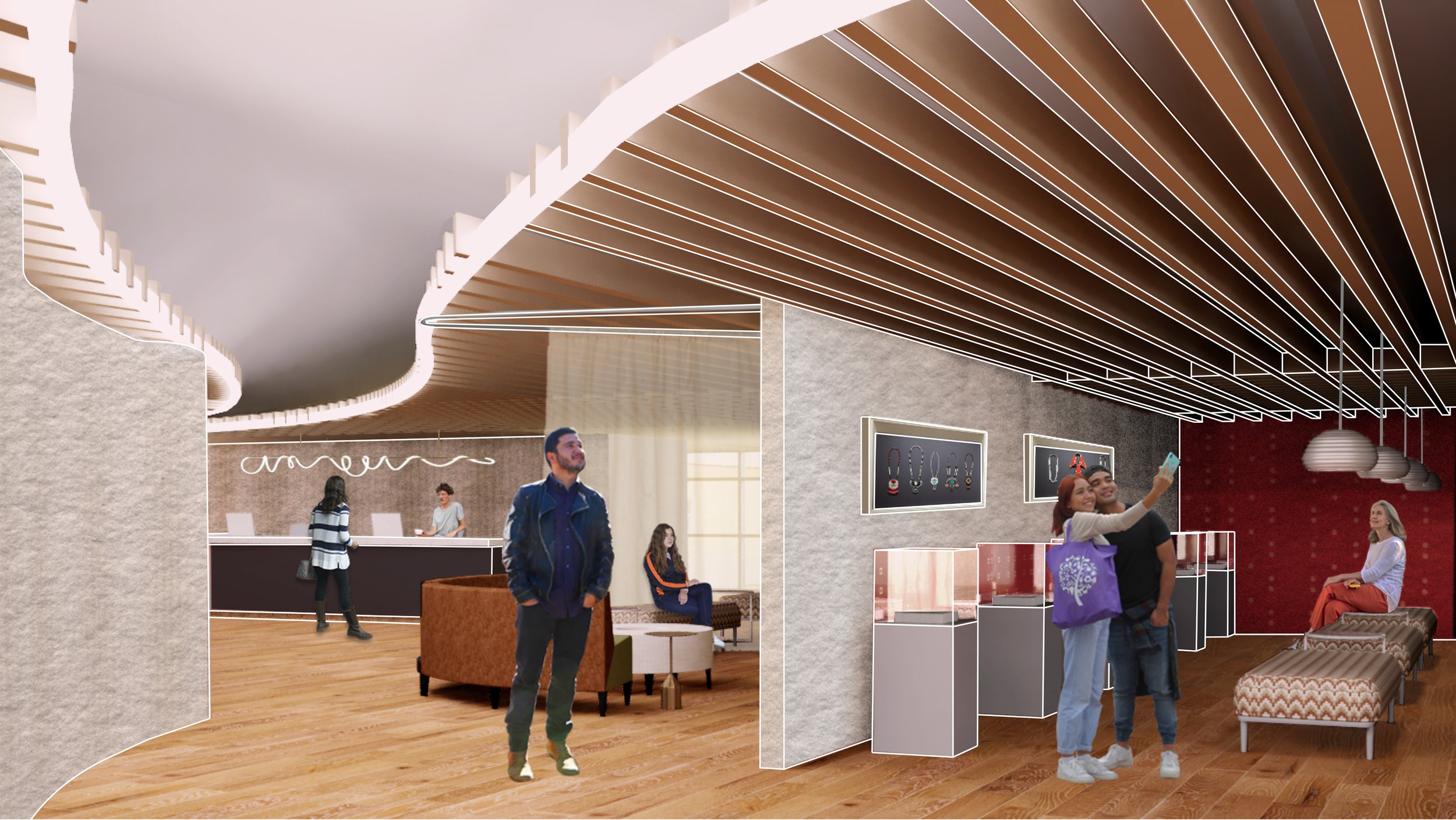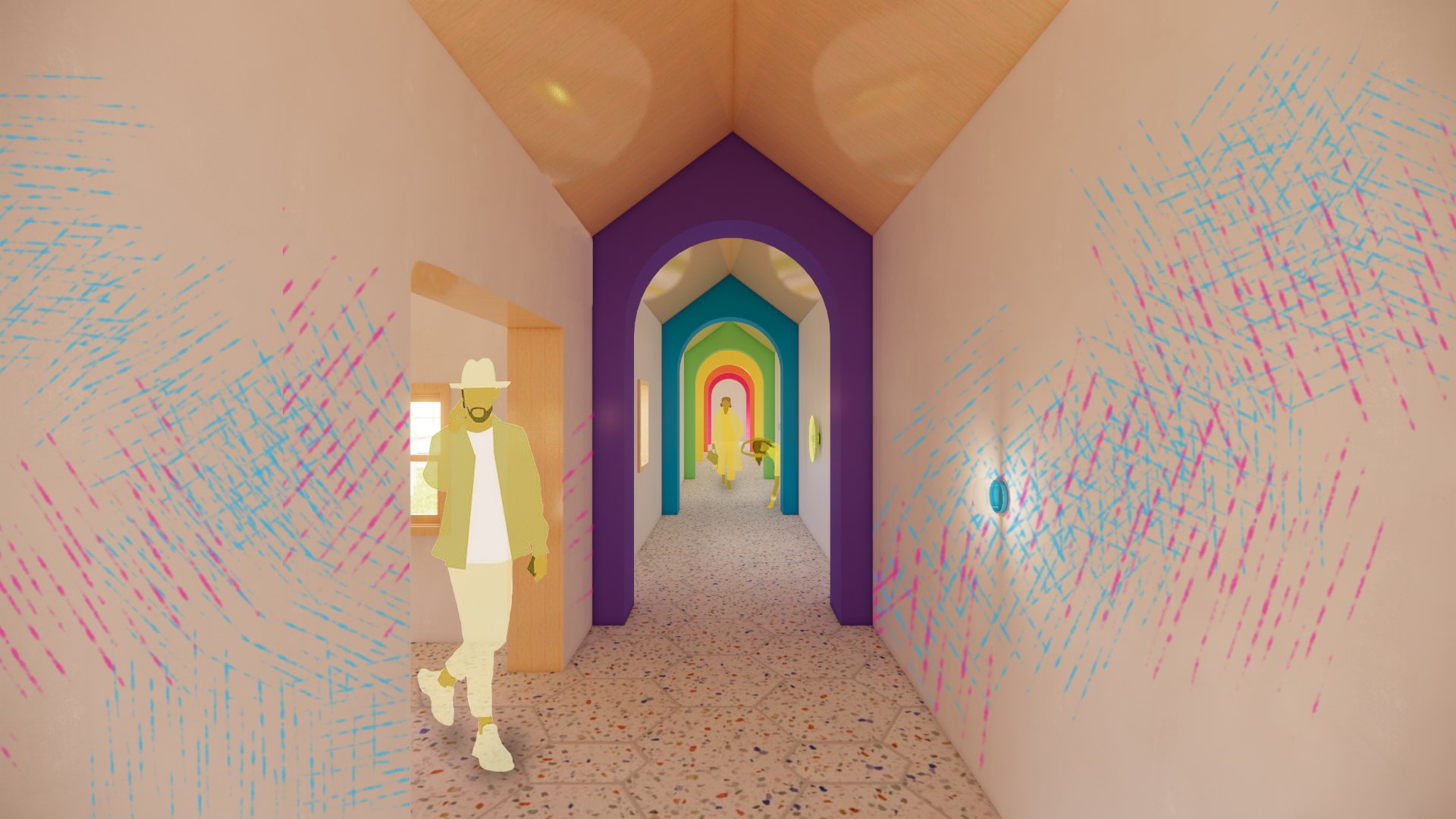Professor Andrea Sosa Fontaine
Throughout the semester, students will focus on intersections of cultural identity in Santa Fe through food+. The unique community architectural and geographic fabric of Santa Fe and its Midtown Campus offers an opportunity for the translation of memories, and cultural and historical identities through a 'palimpsest' of interior spaces. The studio will align with the context of a recent request for proposals to redevelop the Midtown Campus into a new cultural and arts hub.
Olivia Mansier
Food + Sobremesa = Slowing Socialization
Around the Midtown campus in Santa Fe, NM, 54.7% of the community is of Hispanic descent, with cultural connections to Mexico, Central and South American, as well as Spain. Family and community is the backbone of Hispanic values, which includes spending time with one another through an event called Sobremesa. This is an intentional extension of dining, where time is dedicated to reflection, discussion, and the ability to be immersed in communal experiences. A unifier of families and communities. However, as family members grow up, relocate, or become focused on their careers, there seems to be fewer opportunities to slow down and connect. By combining the memory around food and family with the practice of Sobremesa, the barracks can act as a space to support the communal identity through the methodology of slowing down socialization. This will be achieved through a program of informal dining and formal dining with senior center activities integrated into the spaces. Here there will be connections between old and new, past and future, and knowledge and pleasure. A place of intergenerational exchanges.







Professor Tina Patel
The unique community, architectural and geographic fabric of Santa Fe and its Midtown Campus, offers an opportunity for the translation of memories, and cultural and historical identities through a ‘palimpsest’ of interior spaces. The studio aligned with the context of a recent RFP (Request For Proposals) to redevelop the Midtown Campus into a new cultural and arts hub. Students will consider what has been excluded from the RFP and how the design of interior space utilizing food+ cultural intersections can amplify the community’s complex and evolving cultural narratives. Each student will develop their own food+ interior palimpsest as a means of revealing and celebrating Santa Fe’s cultures, identities, and heritage as it relates to building form, space program, and fabrication.
Sarah Price
Food + Inherited Memories
The exploration of the relationship between food and inherited memories presents a promising avenue for indigenous peoples in Santa Fe to reclaim and preserve their cultural heritage. Through engaging in innovative and imaginative practices, a connection to traditional knowledge and practices may be strengthened to increase their resilience in the face of cultural marginalization and loss. Santa Fe’s historical record of pillaging indigenous towns and using statues and parades to commemorate this violent past highlights the need for intentional efforts to engage with the city’s indigenous communities. The central location of Midtown, which connects the north and south sides of the city, offers an opportunity to create a platform for indigenous voices and to activate surrounding areas. Careful consideration of the history and context of the area is crucial in designing interventions that are respectful of the cultural heritage of the communities they seek to engage in and can contribute to positive social and economic outcomes for those communities. An interactive museum of inherited memories can provide valuable insights into the potential of community-led initiatives to foster social justice and cultural preservation in indigenous communities through interactive displays, workshops, gathering and food.







Haylee Fredericks
Food + Agency: Incubator Kitchen & Food Hall
My thesis focused on the demographics of women and how their roles in the workforce has changed over the years. Our site was located on the Midtown Campus in Santa Fe, New Mexico, specifically abandoned barracks buildings used during World War II. I defined my research on the movement women created over the decades as they became leaders in highly skilled professions that originally men were only allowed to work for. Specific to our site, women make up the majority of the population in Santa Fe but were never considered innovators in workforce success. However, in many households, women were considered nurturers as that could eventually lead to cultural changes with their role for a child's nutritional development. My concept was based on the statement, "Food + Agency", a discussion between different cultural groups on how the cooking process can take on a domestic communal identity through empowerment of women in the kitchen. The goal for my project was to design a culinary academy that promoted the integration of women in the kitchen who teach the joys of cultural heritage by passing this agency to the area of Santa Fe. Food, culture, and women's role in the kitchen will correlate together to take agency of women's food culture background and use it to serve the community, so that art and tradition are not lost. A place that fosters nutritional learning, communal diversity, and new patterns of cultural domesticity in the kitchen results as an “empowerment to act” on the Midtown Campus.








Lauren Koval
Food + Celebration
Food + Celebration focuses on the community of Santa Fe, New Mexico which contains a diverse socio-demographic population where various cultural influences are a part of everyday life. Due to the city’s diverse population, it has become very well known for its many fiestas that occur throughout the year which help to honor and celebrate the arts and culture of the residents. As Santa Fe’s diverse population has evolved it has witnessed colonization, history of erasure and socio-political tensions. Some celebrations have even sparked conflicts and rifts across cultures due to the meaning and history behind them. An important aspect within any cultural celebration is the food that is prepared and served. It acts as an expression for cultural identities and offers a common ground whereby communities can come together and fortify their relationships. My project aims to create a public interior where the making, sharing and eating of food becomes the focus of the celebration to help bridge and unite cultures. It will act as an intersection of culture, food and celebration where paths of connection and dialogue will form while working to release tensions that may exist between cultures. This is achieved in the physical environment through a community teaching kitchen and garden, a communal dining court, pop-up vendors and a rotating display gallery that will provide educational aspects on the history and contexts behind celebrations as they surface.







Elissa Mariani
Food + Craftsmanship Culinary Education Center
The act of sourcing, identifying ingredients, learning healthy habits, preparing, cooking and making pieces to store food are elements of the Hispanic craft that brought women together in solidarity and empowered them to become self-sufficient, independent, and leaders of their own cultural identity. This project will explore the significance of food as a craft and craft associated with food, which is essential to Hispanic women’s cultural identity and gender equity in New Mexico. Food is an important aspect of Hispanic culture and can be a factor in the marginalization of people in Santa Fe. Midtown is a primarily Hispanic area and is located in an area that has a larger demographic of women who would benefit from food-based programs. Through a culinary education center that focuses on knowledge and empowerment, the area’s purpose will be to provide a space for Hispanic women in Santa Fe to benefit from programs focusing on food and craftsmanship. In order to address this, this culinary education center will focus on external and internal empowerment through food and associated crafts and will help women and female adolescents become empowered through the making, eating, and learning associated with food, as well as the community it creates.







Professor Britta Bielak
An advanced studio course focused on developing concepts and capacities for independent future practice. Topics will rotate based upon faculty expertise and student research interests as developed in ID 40311 Contemporary Issues and Research. Emphasis will be placed upon advanced theoretical and strategic design development; advanced understandings of social, cultural, and spatial contexts; design as research; advanced representational strategies; and sophisticated design expression across all facets and scales of a project.
Brianna Solt
Food + Relocation
Latino residents of Santa Fe face distinct barriers in accessing aid due to federal limitations and discrimination. Food + Relocation establishes a dedicated location for existing local organizations that promote food equity, education, and community. The resource center forms a co-supportive network in which different programs and users rely on one another. These networks are structured to provide aid and investment that will culminate long-term stability. Through loops that exist in multiple planes, spaces connect and engage with one another to reiterate this concept.






Mya Agee
Midtown Food Hall
Santa Fe, New Mexico is a diverse community with deeply rooted ties to many cultures. The city has a packed calendar schedule with many celebrations that the community members take part in. Many of these communities are facing displacement as a result of the high cost of living and food insecurity. By creating a place that is an assembly of immersive retail spaces, the Midtown food hall can become a place for the community to gather and attain affordable meals to aid in their food insecurity. The economic opportunities for the community can also be an asset to neighboring businesses. The retail spaces will include vendor booths where families and chefs can sell their dishes as well as local ingredients. Additionally, there will be areas for guests to gather and share meals together.







Serene Hawes
Santa Fe Community Co-Op
In response to the 20.1% of Santa Fe Youth that experience food insecurity, the Santa Fe Community Co-Op acts as a resource to low income single parents and families. The program of the space exists in 3 parts: community gardens, a child care center, and a co-op market. This supports the structure of the community through providing access to nutrient dense food, childcare, and gainful employment to parents. The design language of this space communicates through a layering of modified arches that create clusters; a series of networks that are visually representative of a community made up of familial units and geometrically dense, creating interesting and functional pockets of space.






Emma Weaver
Feeding Folklore
FOOD + STORY CONCEPT: The process of making indigenous food is similar to a telling a traditional story, and the processes overlap in different areas called “embraces”. The 3 types of embraces identified are: weaving, supporting, and hugging. Each of these embraces become the spatial frameworks and influence the design of the plan and overall space. Examples of this include blurring the line between indoor and outdoor space that creates a weaved embrace and utilizing warm materials in a wrapping manner to create a hugging embrace. Creating these embraces allows the space to function differently for each user and gives them the freedom to tell their own stories within the space. PROGRAM: Teaching kitchen, commercial kitchen, cafe, storytelling space, community pantry window





